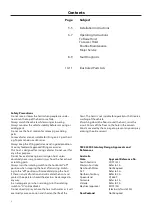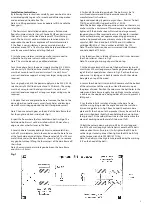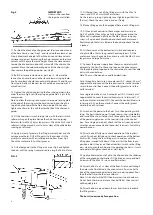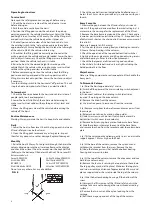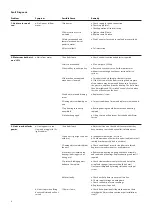
6
7
Inspection Procedure
Lift screw
Thoroughly wash the screw to remove all dirty oil. Inspect the
outside diameter and top and bottom flanks of the thread for
any signs of scoring or uneven wear.
Note: The major diameter may have small intermittent grooves
in its outside diameter which are produced during manufacture.
Inspect the bottom sealing surface for damage where the oil
seal runs. Polish out any small scratches with 400 grit emery
paper.
Inspect the bearing areas and keyway for signs of wear.
Lift nut
Wash thoroughly to remove all oil. Inspect the flanks of the
thread for signs of scoring or uneven wear. If scored, also check
the lift screw and safety nut.
Inspect the thread minor diameter. When new, it is 2.0 mm thick.
If it is worn to less than 0.5 mm thick, the nut must be replaced.
Check that the trigger moves freely and the spring-loaded pin
slides.
Safety nut
Wash the safety nut and brush to remove all oil. Inspect the
flanks of the thread for signs of scoring or wear. Check the
thread minor diameter. When new it is 1.5 mm thick. If it is worn
to less than 1.0 mm thick, the nut must be replaced.
Carriage
Pull the top of the catch bar, at the back of the carriage, 10
mm away from its stop and release it –it must return to its stop
without sticking. Look through the hole in the catch bar pivot
pin. The pin should not be deformed at all –if it is deformed, it
must be replaced. Lubricate the pivot pin and spring guide.
Inspect the four plastic slide pads for wear. There should be no
more than 1 mm wear on the pads. Check the M8 cap screws are
tight. Remove and inspect the bearings in the carriage rollers.
The bearings consist of a layer of bronze particles covered by
a layer of teflon. If the bearing appears to be mostly bronze-
coloured, it requires replacement; if it is mostly grey/green
coloured, it is still in good condition. Do not polish off the grey/
green colour on the roller pin unless the pin is scored. Polish
only with 400 grit emery paper and replace the mating bearing
at the same time.
Lightly grease the roller pin, bearing, roller slides and thrust
washers when refitting. Make sure the circlips are fully seated in
their grooves.
Bottom bearing
Pull the reservoir tube off the bearing housing. Remove the
O-ring, bearing and oil seal. Wash all parts thoroughly. Inspect
the bearings for any signs of pitting or wear on the balls and
raceways. Fit a new seal and O-ring. Repack the bearing with
grease and refit. Wrap in plastic to keep clean.
Top bearing
Remove the cotter pin and remove the castle nut. Remove the
pulley (or spacer) and the top plate assembly from the screw.
Remove the bearing case from the top plate. Remove the ball
bearing, spacer and inner race of the tapered roller bearing.
Wash all parts thoroughly.
Inspect the bearing rollers and raceways for signs of pitting or
wear. Inspect the domed end of the bearing cage and inside the
top plate for signs of wear. Regrease the bearings and refit to the
case. Grease the outside of the bearing case and fit it into the
top plate.
To Re-assemble Column
1. Thoroughly clean the inside of the column where the rollers
and sliders travel, then smear with grease.
2. Refit the carriage and position it about 500 mm up from the
bottom.
3. Check the plastic key covers are still in place in the carriage.
4. Fit the lift nut on to the keys, with the trigger arm through the
hole in the back of the carriage.
5. Fit the load ring between the lift nut and the carriage load bar.
6. Fit the safety nut on to the keys in the carriage, with the brush
towards the front. Leave about a 6 mm gap between the lift and
safety nuts.
7. Carefully fit the lift screw to the column and into the lift nut.
Support the top of the screw on a spacer inside the column.
8. Wind the lift screw through the lift nut and safety nut. Check
the gap between the nuts is 6 mm.
9. Fit the reservoir tube over the bottom end of the lift screw
(square end first).
10. Put some masking tape over the thread and keyway on the
28 mm diameter section. Liberally smear grease over the end
of the screw and masking tape. Carefully fit the bottom bearing
housing, seal first, over the end of the screw and past the
keyway. Make sure the seal is not damaged by the keyway or the
step in the shaft and that the seal spring stays in place.
11. Push the lift screw down through the bottom of the column.
Put some loctite on the two cap screws and bolt the bottom
bearing in place. Fit the reservoir tube on to the bearing
housing, making sure it will clear the carriage when it is lowered.
12. Fit the chain key, sprocket and nyloc nut to the bottom of
the screw.
13. Remove the spacer at the top of the lift screw and fit the top
plate and bearing assembly. Fit and tighten the four M16 nuts.
14. Fit the pulley and key (or spacer) and fit the castle nut. Do
the castle nut up until the chain sprocket is 6 mm away from the
bottom of the columns. Fit the cotter pin.
15. Tighten the sprocket nyloc nut to 80 Nm torque, push the
carriage down towards the bottom of the column and recheck
the 6 mm gap between the sprocket and the columns.
16. Check the two belt pulleys are aligned, fit and tighten the
vee belts to give less than 10 mm deflection when pressed
firmly in mid-span with a thumb. Fit the drive cover.
17. Fit the lubricating brush to the front of the safety nut and
adjust it so the bristles are just touching the bottom of the screw
thread. Pour a trickle of extreme pressure gear oil along the
length of the lift screw.
18. Refit the blind. Tighten the two top screws until the blind
springs are fully compressed, then undo them one turn.
19. Measure the height of the carriages on both columns and
adjust them to the same height.
20. The rest of the assembly can be done by following steps 7
to 26 in the installation instructions, with the additional step
of measuring the gap between the lift and safety nuts after
installation is complete. If new nuts have been fitted, stamp the
new initial nut gap on the front of the carriage.
Note: This hoist is fitted with a special safety interlock which
renders the hoist inoperable should the lift nuts fail completely.
The interlock is fitted to both columns and will stall the hoist
approximately 300 mm off the ground.
Operation of the interlock can be checked using gauge G15-1-
51 according to its instructions.


